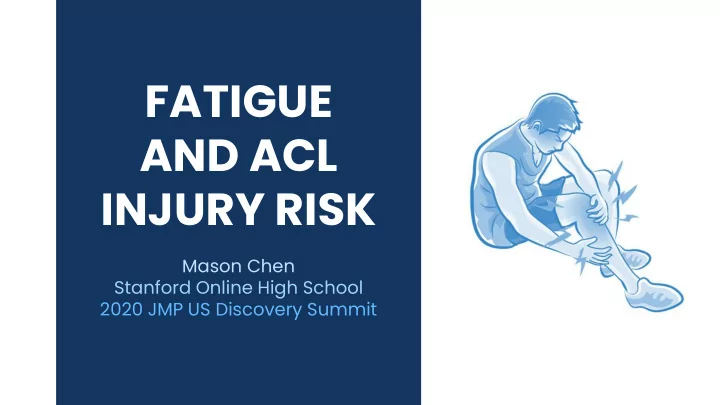

FATIGUE AND ACL INJURY RISK Mason Chen Stanford Online High School 2020 JMP US Discovery Summit
Project Motivation In the 2019 NBA Finals, Kevin Durant ruptured his Achilles while ■ Klay Thompson suffered an ACL injury Thompson won 30 points in the match and helped the ■ Golden State Warriors lead 85-80 before the injury Warriors would go on to lose the match 110-114 and the 2019 ■ NBA Finals, missing a chance of an elusive “three - peat” Thompson was playing his 6 th championship match in just 2 ■ weeks, and his knee was ruptured in the 3 rd quarter Was fatigue one of the major factors that caused his injury? ■
Project Overview ■ Problem Statements □ ACL tearing is one of the most common and dangerous injuries in basketball history □ Recovering from ACL injuries is a brutal and lengthy process (takes months to recover) □ The injury can significantly decrease player’s performance after recovery ■ Project Objectives □ Understand how ACL’s can be torn and what increases injury risk □ Design an experiment that can quantify ACL injury risk before and after fatigue □ Find the relationship between fatigue and angle/force measurements □ Apply JMP tools such as Multivariate Correlation, Clustering, and Control Charts
ACL Injury If tibia (shinbone) is moved too far forward or hyperextended, ACL can be torn ■ Sudden deceleration or pivoting in place □ Foot is planted and body changes direction rapidly □ Common sports that are source of ACL tears: □ Basketball – jumping, landing, and pivoting ■ Football – planting foot and rapidly changing direction, body contact ■ Downhill skiing – ski boots higher than calf, moving impact of a fall to ■ knee rather than lower ankle or leg
Factors Related to ACL Injury Strength and ability to “tighten” quadricep (front of thigh) muscle ■ Response of hamstring muscles (back of thigh) ■ Knee flexion and vertical forces (Newton’s Third Law) ■
Countermovement Jump soft landing hard landing
Experimental Design 7 different sensors were attached to a test ■ Front Back subject while he conducted countermovement jump exercise on force plate (before fatigue) 1 hour fatigue period – running, squatting, ■ basketball, jumping, cone drills, etc. pelvis After fatigue, conducted countermovement ■ jump again to study fatigue factor bilateral thigh Sensor data was transformed through a ■ biomechanical model to simulate the 3D- bilateral shank bilateral dorsum motion profiles
Data Collection
Force Profile Analyze → Quality and Process → Control Chart Builder (Individual) Fz (vertical force) vs Time (seconds) ■ Most soft landing peaks are higher ■ for before than after fatigue Force profile indicates a different ■ behavior between before and after fatigue for force
Individual Force Profile Analyze → Quality and Process → Control Chart Builder (Individual) Pre-jump curve (transition from ■ Soft Landing braking to propulsive phase) is Pre-jump Hard smoother for before fatigue May indicate that different body ■ parts are well coordinated (and no plateau) Landing 2-step (soft and hard) landing ■ Pre-jump Soft Hard mechanism has greater contrast during before fatigue
Multivariate Correlation Analyze → Multivariate Methods → Multivariate Before Fatigue After Fatigue 20 joint angles were collected ■ from the 7 sensors Correlation variables are ■ slightly different between before and after fatigue Much more effective to look ■ at a few key parameters that could represent the fatigue factor
Cluster Variables Analyze → Clustering → Cluster Variables Used to group the parameters in order to identify the most important ones ■ Before fatigue, most variance was explained by 1 st cluster ■ After fatigue, top 2 clusters contributed to most variance ■ Before After Fatigue Fatigue
Flexion Multivariate Correlation Multivariate Correlation differences for the 6 key parameters (ankle, knee, hip) ■ is much more obvious than comparing all 20 joint variables All 6 variables are very well correlated before fatigue ■ Ankle flexion correlation patterns have changed drastically after fatigue ■ Before Fatigue After Fatigue Analyze → Multivariate Methods → Multivariate
Multivariate Control Chart Multivariate Statistical Process Control Chart ■ studies time domain difference More points outside Upper Control Limit for ■ before then after fatigue Before Fatigue After Fatigue 4 2 4 2 5 Analyze → Quality and 1 1 Process → Model Driven 5 Multivariate Control Chart 3 3
Before Fatigue Contribution 4 2 Flexion contribution patterns were studied at each of ■ the 5 points for before fatigue 1 At 1, ankle, knee, and hip are all flexed during bending ■ 5 At 2 (right before jumping off the ground) and 3 (in ■ 3 the air), ankle is the dominant component 1 2 3 Analyze → Quality and Process → Model Driven Multivariate Control Chart
Before Fatigue Contribution 4 2 At 4, during the soft landing, ankle flexion continues ■ to be the dominant component 1 At 5, during the hard landing, hip and knee flexion ■ 5 take over to distribute the forces evenly 3 4 5 Analyze → Quality and Process → Model Driven Multivariate Control Chart
Analyze → Quality and Contribution Comparison Process → Model Driven Multivariate Control Chart 1 2 3 4 5
Conclusions Studied ACL injury causes and techniques to prevent ACL injury ■ Utilized 3D-motion sensors and the countermovement jump to design an ■ experiment that can effectively measure and compare ACL injury risk Used Variable Clustering and scientific reasoning to find the key parameters to ■ analyze (ankle, knee, and hip joint angles) Multivariate Correlation compared before and after fatigue pattern ■ Multivariate Control Chart found specific points where the joint flexion differed ■ most while Contribution Proportion helped understand the effects of fatigue Future research – study 90 degree cut and lateral shuffle exercises which measure different positions of ACL injury risk and is highly used in basketball defense
Recommend
More recommend